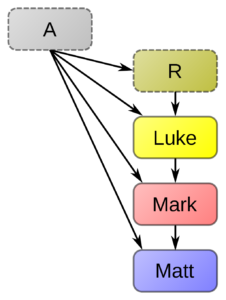Introduction to Lukan Priority
The evidence on this site demonstrates the order in which the Gospels were written is Luke → Mark→ Matt → John. Later gospels are revisions, expansions, and embellishments of the more primitive tradition exhibited in Luke. Numerous articles demonstrate Lukan Priority, Matthean Posteriority with respect to Luke and Mark, and Johannine Posteriority with respect to the Synoptic Gospels. The articles serve to refute theories of Markan Priority, Matthean Priority, and Johannine Priority.
Progressive Embellishment, Luke→Mark→Matthew
The article Progressive Embellishment, Luke→Mark→Matthew examines 36 cases of two-stage embellishment from Luke→Mark→Matthew. These are all cases where Mark is more embellished than Luke, and Matthew exhibits significant improvement or embellishment over Mark. These examples indicate a progression of increased embellishment as the Gospel story was rewritten by Mark and then rewritten by the author of Matthew. The cases examined in this study account for 30% of the entire Gospel of Mark and 25% of the entire Gospel of Matthew. The data and analysis is clear evidence for Lukan priority (Luke was written first) and Matthean Posteriority (Matthew was the last of the Synoptics written). The findings are contrary to popular views of Markan priority, the Two-Source Hypothesis, and the Farrier Hypothesis.
Progressive Embellishment, Luke→Mark→Matthew
The Spurious Emergence of Markan Priority
The article The Spurious Emergence of Markan Priority provides an overview of the modern era of textual criticism from the early stages toward the later work of B.H. Streeter of creating a dogmatic consensus regarding the Synoptic problem. Various factors exercised a deep influence in the development of a fundamentally misleading and false consensus of Markan Priority. The article examines and refutes the primary arguments classically used for Markan Priority.
The Spurious Emergence of Markan Priority
Proto-Luke and Lukan Priority
In the article, Proto-Luke and Lukan Priority, B.H. Streeter’s pioneering scholarship is discussed, giving credence to the view of Lukan priority. Proto-Luke is the concept that the Luke we have today was heavily based on an earlier source more similar to Luke than the other Gospels, and that Luke largely has more primitive material than Mark does.
Lukan Priority and the Jerusalem School
Scholars of the Jerusalem School attest that Luke is most faithful to the Hebraic source material grounding all the Synoptic Gospels. The indication is Lukan priority. The Jerusalem School of Synoptic Research is a group of “Jewish and Christian scholars collaborating in the land and language of Jesus; bringing historical, linguistic and critical expertise to bear on the synoptic gospels,” that holds to the Jerusalem school hypothesis, which is a theory against Markan priority. They provide many evidences to suggest that Luke’s version is the most accurate and that Matthew has been too often unduly influenced by Mark, even when he is correcting Mark with his parallel texts. The surprising result of this research “that of all the Synoptists Luke should prove to be the best in the preservation of earlier texts… the fact that Luke preserves a Greek text which normally retranslates easily to Hebrew and almost always fails to give even a hint of an expression which could be interpreted as the remnant of a Markan non-Hebraism should have led me to suspect that Luke is uninfluenced by Mark and derives his usually excellent translation-text directly from a proto-source.”

Lukan Priority and the Jerusalem School
Statistical Validation of Lukan Priority
The order of the Synoptic Gospels is Luke->Mark->Matthew as indicated by a detailed statistical analysis documented in a four-article series by Halvor Ronning of the Jerusalem School of Synoptic Research. The detailed analysis that includes a review of Triple Tradition, Double Tradition, Single Tradition, Semitic Influence Analysis, and a review of the Non-Linear Hypothesis is summarized in Statistical Validation of Lukan Priority. The extensive analysis indicates Lukan Priority as the best possible of all possible scenarios. Findings that are indications of the Luke→Mark→Matthew model are as follows:
- The elegance with which Lukan Priority explains the verbal identity relationships between the Synoptic Gospels, including its promotion of the minor agreements from a problem to a key part of the solution because of seeing Mark in the middle position (Part 1)
- The ability of Lukan Priority to give a consistent picture of each writer’s relationship to his parallel texts (Part 2)
- The ability of Lukan Priority to account for the level of Semitic influence in the various parts of each Gospel (Part 3)
- Neither Markan Priority nor Matthean Priority can explain the publicly observable facts and verifiable statistics, as well as Lindsey’s hypothesis of Lukan Priority (Part 4)
Statistical Validation of Lukan Priority
Validation of Special Luke: Semitisms
A primitive Semitic source functioned as a primary source for Luke, into which other sources were integrated or to which they were supplemented according to Luke’s overall purpose. Luke did not try to expunge and blend his sources, and particularly, his Semitic source. This is indicated by stylistic differences in Luke and the distinctly Semitic Greek of Special Luke. Luke endeavored to produce a full and final narrative while leaving vestiges of the sources that comprise it. See Validation of Special Luke: Semitisms.
Validaiton of Special Luke : Semitisms
The Hebrew Gospel and Luke
The Hebrew Gospel, cited by church fathers, is the fountainhead of the Gospel tradition. Luke, not Matthew, embodies this primitive Gospel tradition. See The Hebrew Gospel and Luke.
Mark the “Re-Write Man”
In the Article, Mark the “Re-write Man” Editorial Changes in Mark are outlined as previously documented in an article by David Bivin of Jerusalem Perspective on Mark’s Editorial Style. Mark was not interested in transmitting his sources as he had received them. Instead, Mark’s editorial style is characterized by creativity. Lindsey noted a number of characteristics in how Mark treated his sources.
- Relocation of parts from the Lukan order to a new context.
- Rewriting parts by substituting synonyms for the words Mark found in his source(s).
- Rewriting parts using vocabulary Mark had picked up from various later sources. These “Markan pick-ups” allowed Mark to show how the stories about Jesus resonated in the experiences of the later Church.
- Radical abbreviation in some places
- Expansion of parts by adding detail and duplicating phrases
Summarized are the various Grammar, Vocabulary, and Literary Techniques that can be identified by analyzing Lukan-Matthean minor agreements against Mark and by comparing Markan usage to the style of Luke (Mark’s main source).
Mark the “Re-Write Man”
Mark Borrows From Luke-Acts
In the article Mark Borrows from Luke-Acts, the editorial methodology of Mark is evidenced by examining the first chapter and instances of borrowing from other contexts of Luke-Acts throughout Mark. The Midrashic method that the author of Mark employed is one of homologizing and blending terminology from various sources in the composition of the work. Mark’s principal method was to replace about half of Luke’s earlier and more authentic wording with a variety of synonyms and expressions he culled from certain Old and Net Testaments.
The author of Mark rewrote various Lukan pericopae using vocabulary Mark had picked up from the sections of Luke that Mark had omitted, from Acts, from the Pauline Epistles and from the Epistle of James. These “Markan pick-ups” allowed Mark to show how the stories about Jesus resonated in the experiences of the later Church. Mark further exhibits a pattern of replacement, chiastic change, synonymity and word expansion.
List of Markan Stereotypes and Pick-ups
Mark’s version of the Gospel story is dramatic, exaggerated, creative and exciting, just like the creative interpretations of Scripture found in aggadic midrash and the targumim. Mark resembles a modern graphic novel, as it has features that are similar to comic book stories. Like a comic book, the Gospel of Mark uses bold lines and vivid colors that attract a reader’s attention. A Markan stereotype pertains to these unique alternative words and phrases incorporated in Mark that exhibit a pattern of use.
For example, Mark’s strange use of “immediately” εὐθύς (evthūs) is perhaps the most famous Markan Stereotype. It occurs 41 times in Mark, and reminds one of changes of scene in a comic book from one frame to the next. εὐθύς (evthūs) only occurs once in Luke 6:49, but was likely the inspiration for the prolific use in Mark. In typical Markan style, the single instance of εὐθύς in Luke (Luke 6:49) is not paralleled in Mark.
List of Markan Stereotypes and Pick-ups describes the most common Markan pickup and also links to a more extensive catalog of redactional words and phrases characteristic of the editorial style of Mark. Contributors to Jerusalem Perspective noted, “The purpose of the catalog is to collect in one place all the examples that might qualify as Markan pick-ups so that the cumulative effect of the phenomenon can be measured… While it may be easy to dismiss any one example as random, inconclusive, or explicable on other grounds, the cumulative evidence becomes more impressive.”
List of Markan Stereotypes and Pick-ups
Embellishments of Mark
There are numerous embellishments in Mark. Mark exhibits the expansionist characteristics of a Jewish midrashic or targumistic storyteller. Due to this ‘targumic’ activity, the stories Mark told are almost always (literally 80% of the time) longer than the parallel accounts in Luke and Matthew. Mark is the longest Gospel, not the shortest in terms of the actual stories he decided to incorporate. Mark is the shortest only in terms of overall length, but that is only because of the stories and sayings he chose to omit. Mark’s expansionist style fits his character as a sophisticated targumic storyteller.
Embellishments of Mark listed include material unique to Mark or material in which Mark amplifies or adds sensational accounts to the text which is not substantiated by the primitive tradition of Luke.
Mark’s Rewriting of Jesus’ Last Week
Examples of rewriting in Mark’s account of the episodes of Jesus’ last week reveal numerous instances where Mark restructured his story based on various motives. These are highlighted in the article Mark’s Rewriting of Jesus’ Last Week which The demonstrates that that Luke preserved a more primitive form of the account, a form that is independent of Mark’s influence.
Marks Rewriting of Jesus’ Last Week
Matthean Revision to Mark
The Gospel of Matthew was written after the Gospel of Mark was written. Matthew is clearly dependent on Mark for much of its content (95% of the Gospel of Mark is found within Matthew and 53% of the text is verbatim (word-for-word) from Mark). Matthew carries over some defective changes made in Mark. The Gospel is attributed to Matthew because of the presumption that some of the unique source material may have come from Matthew (a disciple of Jesus who was previously a tax collector) although most of the source material is from the Gospel of Mark as many see it is an embellishment upon Mark. What is clear is that Matthew is the combination of source materials rather than that of a single disciple or source.
Matthean Revision to Mark documents how there are Markan Defects exhibited in Matthew. In addition to Lukan priority, the Jerusalem School has demonstrated that Matthew is a derivative work of Mark.
Evidence for Matthean Posteriority
This article presents evidence for the author of Matthew having used Luke in the composition of the Gospel of Matthew. The view of Matthew being the last of the three Synoptic gospels and having a dependency on Luke is known as Matthean Posteriority. Posteriority is the state of being later or subsequent. In addition to the Jerusalem School, this view has been advocated by numerous bible scholars over the last few hundred years. Other NT scholars have recognized the merits of Matthean Posteriority. See More: Evidence for Matthean Posteriority
Evidence for Matthean Posteriority
Survey of Matthean Posteriority Scholarship
There is extensive scholarship since the 18th century attesting to and highlighting key arguments for Matthean Posteriority. See More: Survey of Matthean Posteriority Scholarship
Survey of Matthean Posteriority Scholarship
Refutation of The Farrer Hypothesis
According to this theory, Luke was written after both Mark and Matthew and the author wrote with Matthew as a reference. The implication is that Luke made corrections over Matthew and Mark in many respects. Mark Goodacres’ paper on editorial fatigue in support of the Farrer Hypothesis is refuted in the article Refutation of the Farrer Hypothesis
Refutation of the Farrer Hypothesis
Progressive Embellishment of John
In the article, Progressive Embellishment of John, 8 parallel cases are examined which show progressive embellishment through the Gospel tradition in the order of Luke→Mark→Matthew→John, the least reliable.
Progressive Embellishment of John
Luke→John, Johannine Dependence on Luke
Summarized are 18 passages exhibiting a literary relationship between John and Luke. The evidence refutes views of priority or literary independence of John.

